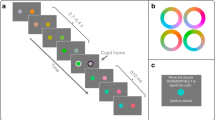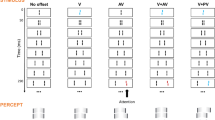Abstract
It is well known that the visual system summates signals over time, about 120 ms in daylight1,2. Although this summation has the obvious advantage of enhancing visual sensitivity, it creates the potential problem of motion smear when viewing moving targets, whose images are also summated over time3. Here I report some measurements which reveal that provided the moving target is exposed for long enough to elicit a dear sensation of motion, the amount of smear is far less than may be expected. This suggests that the visual mechanisms which signal motion are also responsible for signalling a clear unsmeared perception of the target in motion.
This is a preview of subscription content, access via your institution
Access options
Subscribe to this journal
Receive 51 print issues and online access
$199.00 per year
only $3.90 per issue
Buy this article
- Purchase on Springer Link
- Instant access to full article PDF
Prices may be subject to local taxes which are calculated during checkout
Similar content being viewed by others
References
Graham, C. H. & Margaria, R., J. Physiol. 113, 299 (1935).
Barlow, H. B. J. Physiol., Lond. 141, 337 (1958).
Burr, D. C. thesis, Univ. Cambridge (1979).
Newton, I. Opticks, 347 (1730, reprinted Dover, New York, 1952).
Effron, R. Neuropsychologia 8, 57 (1970).
Hogben, J. H. & Di Lollo, V. Vision Res. 14, 1059 (1974).
Ross, J. & Hogben, J. H. Vision Res. 14, 1195 (1974).
DeSilva, H. R. Br. J. Psychol. 19, 268 (1929).
Westheimer, G. & McKee, S. J. opt. Soc. Am. 65, 847 (1975).
Smith, W. M. & Gulick, W. L. J. exp. Psychol. 53, 145 (1957).
Matin, L. in Handbook of Sensory Physiology Vol. VII/4 (eds Jameson, D. & Hurvich, L. M.) (Springer, Berlin, 1972).
Morgan, M. J., visison Res. 19, 491 (1979).
Cornsweet, T. N. Am. J. Psychol. 75, 483 (1962).
Westheimer, G. Archs Ophthal. 52, 932 (1954).
Tolhurst, D. J. J. Physiol., Lond. 231, 385 (1973).
Kulikowski, J. J. & Tolhurst, D. J. J. Physiol., Lond. 232, 149 (1973).
Author information
Authors and Affiliations
Rights and permissions
About this article
Cite this article
Burr, D. Motion smear. Nature 284, 164–165 (1980). https://doi.org/10.1038/284164a0
Received:
Accepted:
Issue Date:
DOI: https://doi.org/10.1038/284164a0
This article is cited by
-
Prior Experience Alters the Appearance of Blurry Object Borders
Scientific Reports (2020)
-
Shape representation modulating the effect of motion on visual search performance
Scientific Reports (2017)
-
The buzz-lag effect
Experimental Brain Research (2016)
-
Hoverflies are imperfect mimics of wasp colouration
Evolutionary Ecology (2016)
-
Implied motion perception from a still image in infancy
Experimental Brain Research (2014)
Comments
By submitting a comment you agree to abide by our Terms and Community Guidelines. If you find something abusive or that does not comply with our terms or guidelines please flag it as inappropriate.



